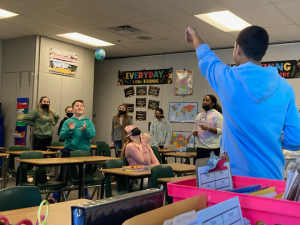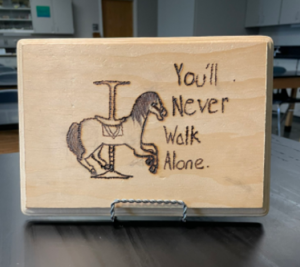As you enter the classroom, the lights are dimmed and a dozen students are scattered throughout. Some are folding origami; another is using a wood burning kit to etch a magnificent dragon plaque. Others are reading quietly. You have entered the “Calm room.” It’s one of four rooms that 6th graders at Olmsted Falls Middle School outside Cleveland, Ohio, can select during their STAR advisory period.
This unique approach to advisory time was actually born of frustration among a creative and collaborative team of teachers that includes Eric Bartkowski, Kristen Gillespie, Casey Lehmann, and Kim Urban. “Kids were spending the entire period playing on Chrome books, or feeding off each other in a negative way,” explains Eric, the team’s science teacher, “we thought, we have got to start spinning our wheels to find a better way to utilize this time.”
What they came up with is a student choice-based advisory period driven by what each individual student needs on a particular day. After beginning the 45-minute period with silent reading, students can then select the room that best aligns with their present needs:
- Play – Students enjoy tech-free, collaborative play time. This could include board and card games, silent ball, heads up 7 up, etc. Students work collaboratively to decide what they’re going to play that day.
- Move – Students engage in activities that get them out of their seats and moving around. When AMLE visited, the nice weather had prompted the kids to suggest walking the school property to pick up litter.
- Calm – Students can read quietly or engage in other activities arranged by the host teacher that have included yoga, making friendship bracelets, or wood burning projects.
- Think – Students can get additional classwork help, work on assignments, or catch up if they’ve been out.
The STAR period runs every other day, giving students multiple opportunities to select rooms over the course of a quarter. While students can select the Think room as many times as they’d like, visits to Play, Move, and Calm are limited to five per quarter. The team switches which teacher runs each room bi-weekly and they track students’ visits to each room – providing useful data like where students are spending most of their time (the social butterflies are frequent visitors of the Play and Move rooms) as well as how they’re managing their room choices. A sample student tracking table might look like this:
|
Think |
Move |
||||||||
|
3/9 |
1/31 | 2/14 | 2/16 | 3/17 |
|
||||
|
Calm |
Play |
||||||||
|
2/23 |
3/1 | 3/15 | 1/25 | 2/2 | 2/8 | 2/10 |
|
||
Post-COVID, the team also observed the students struggle with the Chromebook-free Play room. “At first they were just staring at me,” Kim describes, “I was like ‘Play!’ And it was like they didn’t know how. They were shying away from free play, which was different from past years.” The inclination to isolate has improved over the year, and now they even observe students who wouldn’t normally socially interact positively engaging with each other.

The teachers have observed several other benefits to the new approach. As one example, in addition to providing more opportunities to build relationships with students, the students are also getting to know their teachers better. What Calm looks like in Casey’s room is decidedly different than Eric’s approach. “He’s the only one burning wood during Calm,” she jokes. Alternatively, math teacher Kim led a Yoga session, doing it along with the students. “Some of them were into it right away, and others were shyer.” Kristen, the team’s language arts teacher, added that it’s key to play to your strengths as a teacher. This also provides an opportunity for them as teachers to enjoy some rejuvenation during the day.
Providing structure, while allowing for the lack of structure, has been a key component of the program. Allowing choice among rooms has encouraged students to draw on executive functioning skills like planning and organization. We spoke to one student who said he enjoys the program because he can “do what works” for him. If he knows he has a busy afternoon, he may choose the Think room to get ahead on homework. Sometimes, of course, students make poor choices – which provide teachable moments. If a student chooses the Play room and then arrives at their next class without an assignment, that’s an opportunity for a conversation about how today would have been an ideal day to choose Think. The key is to have those conversations and not to gloss over them, the team explains.

There are social and emotional benefits as well. One student described it as, “giving you time to think, like if you’re in a situation, you can use that time to talk with your friends about it.” Encouraging students to get in tune with their own needs was an intended consequence of the program, the teachers say. Eric added, “It really is focused on what does the individual get out of it and what was their reason that day.”
While the team continues to tweak and refine the program, we can say that we saw several of the characteristics of The Successful Middle School: This We Believe in action during our time at OFMS, ranging from the benefits of a collaborative team of teachers to the positive impacts of adult advocacy and student choice. We look forward to seeing the program continue to grow.

This is a really cool way to help students reset during the day. It offers ways for them to collaborate and socialize with each other, while still giving the ones who need it the time to catch up.
I really liked the ideas presented in this article; students who experienced Covid during their education will especially benefit from this approach. This offers social and emotional benefits for students while giving them multiple opportunities to experience new things and collaborate.
I think that this STAR advisory period is an excellent idea for giving students time throughout the day to blow off some steam and engage with their interests. Dividing the activities into play, calm, move, and think categories is a great idea as it allows students to meet new peers who may have similar interests or levels of social engagement throughout the school day. I additionally think this period is essential for engaging younger students as they come back from COVID and struggle with appropriate self-regulation in the classroom.
The breakdown of choices that the student have are amazing. Allowing them to choose from Play, Move, Calm, Think rooms allows them to decide for themselves while also keeping the restrictions (number of days allowed in each room) in mind. I feel that this structure of an advisory program truly benefits students social and emotional development by offering opportunities for students to connect with their peers and educators and establish a sense of belonging.
This article was simultaneously exciting and disheartening. With the pandemic hitting everyone in different ways, our students have been hit in ways we couldn’t have imagined. Things as simple as playing are now tasks to complete. I always love when students have the option to choose and having so many options that are creative helps students immensely.